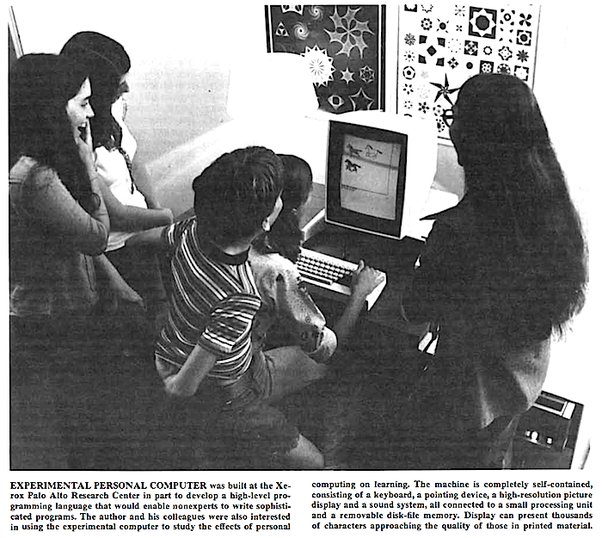Beginnings
From the desks @paperland.
“…[the computer] is a medium that can dynamically simulate the details of any other medium, including media that cannot exist physically … it has degrees of freedom for representation and expression never before encountered and as yet barely investigated.”
––– Alan Kay, Sunrise Notes Number 2, June 1990, p.29
Thinking
Thinking is often intertwined with the context in which it is done in and expressed with. Even the tools used to express thought influences the thinking itself. Two of the greatest of such tools have been writing and mathematical notation. These tools help us scafold, adapt and even extend our thinking processes. Such powerful tools need not only be notational or symbolic in nature. They can be physical too! For example, in the presence of an abacus, the human mind exploits it much like a scaffold around which to structure cognitive operations. The abacus extends our thoughts from the human minds into the external world. Since then, other computational environments have been at the forefront of this process of helping people and businesses reason about processes that they want to observe, intervene, model and share.

The problem today is that computers are still being ill treated as modes for instruction in class when in fact, they are a far richer tool as modes for interaction. It is still the child and the paper and the teacher, just that the paper has been substituted for the screen.
Interacting
Every child can be expected to tactily be able to play around with blocks of wood or the paint brush but adding vectors or creating a tangent or reasoning about an exponential is thought out of their reach. That is because traditionally, the only way to express these have been via pen and paper after what has been rigorous instruction.
However, with a computational environment, Seymour Papert called this process the microworld where all childen engage in creation of little pockets of reality, where they grow a sense of bearing and footing to feel at home in with a piece of knowledge (say counting but in counting using hands world or using coins world or using clocks world etc.). He believed computers is the interactive tool through which the process of exploring these microworlds suited for education becomes “a more natural and spontaneous one, similar to the way children learn language” interaction can take the place of instruction and the shared construction of a rich simulated world for example one of wolves eating sheeps or the spread of wildfires can easily help kids play around with “abstract concepts” like exponentials and decay functions simply by doing and manipulating simple parameters.
We need a process to support our thinking about other things around us.1 “Computation” here is just a means of representation of just such a process - it is meant for trying out ideas with and get objective results as opposed to a situation where they could only think about it inside their heads, unable to bring those ideas out into the world and see the results.
We believe that computers are a means to enlarge and extend the reach of human thought itself.
Teaching
Surprisingly, students are very comfortable with adapting new technologies. It is the teachers that serve as the gatekeepers to better thinking tools. To cultivate an environment that enables active learning, addressing the needs of the teacher is essential. It is they who can relate and touch the chords that resonates with the experiences of the learners in classroom. Hence, the environment which the teacher introduces to the classroom has to feel familiar to them and gain their confidence.
Teachers need to feel confident in navigating and contextualising learning through the tool.
This would be in building the right scaffoldings for onramping teachers.
Classrooms time which would be the most fruitful of time to conduct such exploratory learning also happen to be the most scarce.
We need to facilitate their ability to moor the class and intervene with confidence when needed (e.g showcasing one of the learners work / debugging a gap in the mental picture of a student)
We believe that teaching computation should enable a lively process of co-discovery between teachers and students.
Together
The learner is most consciously engaged when building something in the open with others, whether it’s a sand castle on the beach or clamping lego bricks together. They look over each others shoulder, push around what their friends have done, try to copy what others are doing, or start something totally different from what others are doing, pick up half an idea here and another half from somewhere else, show off what they have done in their own way, express what they already see in their head.
The fundamental aspects of collaboration, exploration, and building together are universal.
Whether it’s children playing and learning through building and sharing ideas, or seasoned software developers working on projects together, the core principles of engagement, collaboration, and learning through doing are the same.
The colloborative, cooperative and competitive behavior is what drives and brings momentum in learning to everything from sports to music.
Why then is our first programming class we start with a single player shell or notebook that we use on your own?
Any online multiplayer game seems to have a better idea what it means to colloborate to achieve shared objectives in realtime together.
Seasoned programmers rely on purposeful asynchronous collaborative tools such as Git to achieve shared goals but what is its equivalent in a synchronous live classroom setting?
We believe that learning computation should spur the spirit of conviviality and camraderie in us just as any street sport would.
In Paperland, we believe in bring people together in discovering the joy of the world through computation
-
“You can’t think about thinking without thinking about thinking about something. – S.Papert” ↩